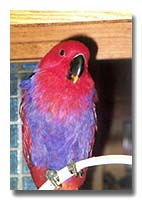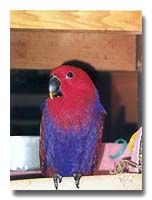| |
|
Seeing
Clarity: December 2001
 A
22 week old Eclectus hen named Clarity takes a splashing bath along
the kitchen window sill. Head down, Clarity skims her beak along
the sill dotted with chard leaves and dripping with water. The vertical
blinds click as she passes behind them. Half way down the sill,
she peeks out to see if I am watching. She laughs out loud, shakes
her gold-banded tail, fluffs her wings, and romps to the other end
of the sill. A
22 week old Eclectus hen named Clarity takes a splashing bath along
the kitchen window sill. Head down, Clarity skims her beak along
the sill dotted with chard leaves and dripping with water. The vertical
blinds click as she passes behind them. Half way down the sill,
she peeks out to see if I am watching. She laughs out loud, shakes
her gold-banded tail, fluffs her wings, and romps to the other end
of the sill.
Plop,
she jumps onto a basket handle, munches a piece of chard, then hops
back to the sill to continue her toilette. While these behaviors
might seem “normal” for most well developed 20 week old
psittacine birds, Clarity’s accomplishments of such feats are
special.
Clarity
was hatched with visual impairment. While she is not blind, her
vision was first diagnosed and then physically confirmed as deficient
by Christine Sellers, DVM. A long and complex developmental program
devised by Dr. Sellers and myself brings Clarity to the window sill,
bath, and the wet wiggly girl before me now. Additionally, I thank
the watchful expertise of Harry Linden, Margo Rose, Lori Reilly
Walton and Jody Bright, and her own indomitable spunk, for the Clarity
I see today.
A Brief History
I
consulted with an avian expert on Clarity’s development. I
scheduled a telephone consultation with Christine Sellers, DVM,
avian veterinarian for SBBF and owner of the Cat and Bird Clinic
in Santa Barbara. On 9/05/01, Dr. Sellers heard my version of the
story.
“It
sounds to me like she might have impaired vision,” said Dr.
Sellers. “Birds who cannot see well are often on guard. She probably thinks the
world is scary and somehow knows that she is not perfectly equipped,”
she explained. However, there was good news: “As do the tissues
of the G.I. tract, avian eye tissues have a rapid cellular turn-over,”
Dr. Sellers explained. “That’s why chemotherapy is so
devastating to both types of tissue. The tincture of time and a
very controlled dark environment are needed for optimal avian eye
development,” she instructed. Then she offered even better
news: “Still, it is not unusual to see birds with impaired
vision. Tissue types that have a rapid turn-over may also have the
ability to regenerate. Even when left with some impairment, psittacine
birds can learn to accommodate.” Upon further discussion, the
light went on for me and I immediately named this fledgling Clarity. who cannot see well are often on guard. She probably thinks the
world is scary and somehow knows that she is not perfectly equipped,”
she explained. However, there was good news: “As do the tissues
of the G.I. tract, avian eye tissues have a rapid cellular turn-over,”
Dr. Sellers explained. “That’s why chemotherapy is so
devastating to both types of tissue. The tincture of time and a
very controlled dark environment are needed for optimal avian eye
development,” she instructed. Then she offered even better
news: “Still, it is not unusual to see birds with impaired
vision. Tissue types that have a rapid turn-over may also have the
ability to regenerate. Even when left with some impairment, psittacine
birds can learn to accommodate.” Upon further discussion, the
light went on for me and I immediately named this fledgling Clarity.
With
incisive clarity of her own, Dr. Sellers helped me see the following:
“This little girl knows she has a disability,” she asserts,
“so she perceives the world as a threat. When you can interpret
her disability for her, her accommodation skills will increase.”
Our
discussion continued to incorporate management techniques for Clarity,
all of which made perfect sense to me. Additionally, I scheduled
a physical exam for Clarity, her clutch mate and for Cella, (our
18 year old vos companion) so that Dr. Sellers could examine three
pairs of Eclectus eyes in one visit. The oscilloscope revealed that
Clarity’s eyes look very different from the other Eclectus’
eyes Dr. Sellers looked at that day.
Back
at home, I changed first my attitude, then my management of Clarity.
I acclimated her increasingly to being held in a towel and she still
enjoys that comfort. Upon Dr. Seller’s recommendations, I limited
the amount of change in her physical environment and set the baskets
and box on the counter in recognizable configurations for her. Lots
of stability was provided. Additionally, I continued to test her
eyes, to gently challenge her to look and see, and discovered that
she seems far sighted with one eye and close sighted with the other.
Further, I discontinued the non-discretionary use of artificial
light and chose instead to keep maximum amounts of real UV suffused
sunlight as Clarity’s primary source of illumination.
Clarity
Progresses
As
the weeks pass, Clarity’s physical skills progress nicely.
By now, she knows many different basket/perch/box configurations
and navigates them with good coordination. When she flies, she lands
on white towel covered landing spots. In natural light, she walks
towards me with confidence and readily steps up and down and enters
and exits a variety of cages with complete compliance. She manages
quite well in two cages of disparate sizes and configurations and
is always willing to enter and exit the cages upon my clear request.
Perhaps
not surprisingly, Clarity demonstrates precocious vocal skills.
She already says three distinct greetings and every day increases
her repertoire of expressive vocalizations. She sings under her
breath while playing and praises me when I open the windows every
morning.
Clarity’s Future
As
a Santa Barbara Bird Farm bird, Clarity’s long term future
is secure. My fascination with her developmental progress continues
in direct proportion to the joy in both learning from and teaching
this remarkable girl, the latest addition to our flock.
|
|
|





